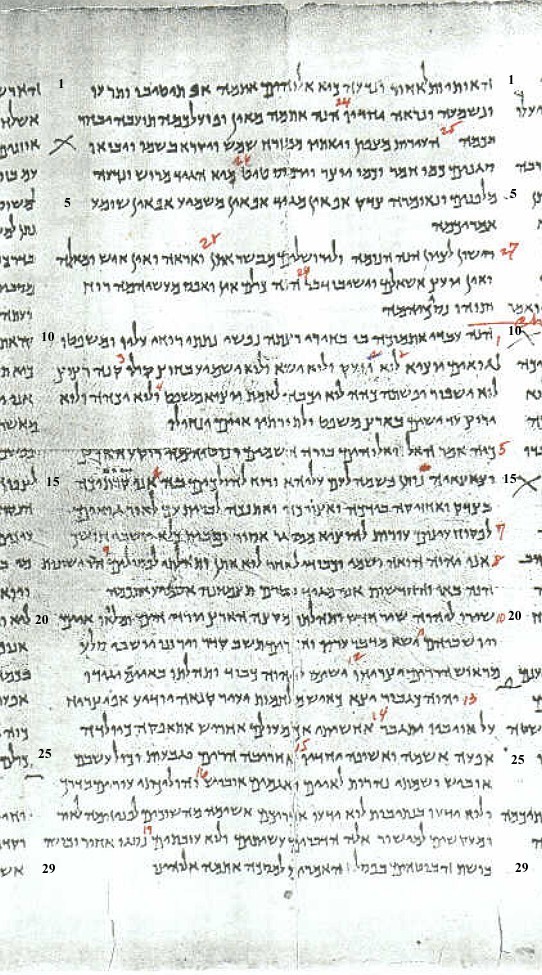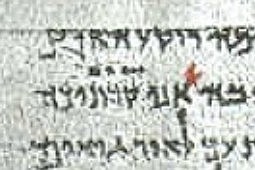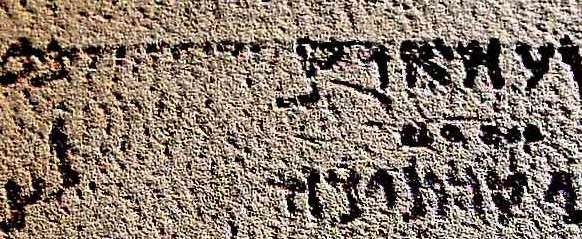
The Great Isaiah Scroll 41:23 to 42:17

Physical Characteristics:This is the mid page of three in the 11th piece of leather that makes up the scroll. It is in good condition except for a crease that extends from top to bottom in this page. Some splitting has taken place through age in what was probably a fold in the original piece of leather. Some letters are slightly obscured but not obliterated (except for the tserey in line 21) by this crease on lines 19, 21, 22, 27. A small amount of surface chipping is found between lines 21 and 22. Otherwise the page is easily read.
Paragraphs and Spatiums:
Paragraphs are indicated in the usual way of not filling out the preceding line before the new paragraph. Thus are marked line 7 = 41:27 and line 10 = begin chapter 42; and line 14 = 42:5; and line 20 = 42 10. An indentation indicates a new paragraph at line 23 = 42 13 which is also marked by an editor as explained in the next section below. The last line on the page is the end of a paragraph and the next page therefore begins with a new paragraph or vs 42:18.
Editorial marks:
The most interesting of the editorial marks are found over the last word in line 15. There are what appear to be four or five dots that are meant to cite an omission by the original scribe. The received text has the NAME (YHWH) just before the last word. The editor usually indicates the omission of the NAME and then rewrites it in the margin but here the omission of the NAME seems to be noted by what appear to be, but are not. dots and the NAME is not written in as is usual in other places where editing of omissions are cited. Obviously the editor knew the text required the NAME and he indicated its presence, or lack of presence, by what at first appear to be 4 or 5 dots. Upon further investigation; the dots have a definite shape to them. See the enlargements below which indicate that the dots have shapes some of which are similar to Aramaic letters. The popular explanation that the "dots" are the remnants of an erasure of the divine name (YHWH) does not seem adequate for this scribal notation. There does not seem to be any relation of these marks to the written form of the NAME in any ancient script. See the page where the ancient scripts used in the DSS for the NAME are described. Click here.
Any ideas anyone?
For an extended discussion of the use of dots by the Q scribes see the introduction.
Actual size
Magnified slightly

Magnified greatly

The copies below of the J. Trever photographs of these "dots: was submitted by Dr Andrew Hua of Australia. These copies show interesting and apparently more accurate details.
Enlarged further
In the enhanced view below there is a notation that was erased at the end of line 14, just above the "dots" of line 15, which extends across to the next column. It is possible that the scribe wrote too far on the line and erased the last word and placed it as the first word in the next line. The seven letters of the word extended just too far. Note that the last word in line 18 extends into the margin but there is still room for margin. This word would not have left space. The erased notation can be seen with careful inspection in the copy of the full page above but it is much more apparent in the photo below. The reason that the erasure was not complete and this remnant remained may be answered by the fact that this erased word was enscribed on a natural crease or split in the leather into which the ink "bled" and was therefore difficult to completely eradicate.

Other Editorial Marks
An X in the left margin most likely sets off vs 41:25 as a verse important to the editor. It follows the precedent of the preceding page where X's set off vss 41:8 to 11 as an important passage. There too the X's are found also in the left margin. Thus the X is meant to mark this page and not a passage in the next page. There is nothing on page 36 at this point that would seem important enough for a scribe to add an X to the page. The passage so marked here is one describing important elements of Cyrus the Persian which impressed the editor because of Isaiah's precognition of events and characteristics which would have been historically known to the editor. This verse is also set off by the original scribe by a spatium.
"Derby" Editorial Mark in the right margin at line 23. The mark which we see as resembling a wide brimmed hat is described in detail on page 28, which see. It is usually used to set off the beginning of an important section. It is less obvious here but a reading of the text shows that the vss 41:1-12 are very messianic and 13 begins a more general description of spiritual needs of the nation for change with the action attributed to YHWH while 1-12 is a description of the Righteous Man and his activities led by YHWH. This may account for the editorial mark showing a change of section.Editorial additions to the text:
A yod is written above the 2nd word in line 9 which does not seem necessary to pronunciation. The four dots above the last word in line 15 have already been mentioned; and a waw is written above the next to last word in line 20. The mark over the mem in next to last word in line 22 may be a careless ink spot; 3 more spots like this are seen in the margins at the lower right and between line 26 and 27 on the preceding page.
Q Scribal Spelling:
As stated previously I will not notice the addition of yod and waw as vowel indicators nor the addition of "he" to the end of suffixes and other words in general; nor the common use of "kemah" as the spelling of 2mpl suf. nor the addition of aleph to words like "lo, miy and kiy" all of which are variations from the M text. The addition of "he" to the end of words is very frequent ,---too frequent to take continual notice. It should be remembered that the Q scribe used these mechanisms for pronunciation helps similarly to the later addition of vowel pointings by the Masoretes. However the addition of "he" or aleph to the end of a word adding an extra open syllable to the word is indication of an Aramaic "accent." See, for example, addition of aleph to " 'aleyha" (upon it) 5th word in line 15
Variations in Q from the Masoretic Text:
Line 2: 1st word: Q = "ve-nishma'ah" (and we will hear) and M = "ve- nishta'ah" ( and we will be dismayed) A different reading. Between the 7th and 8th words: Q omits the word found in M = "me:'aph a' " which M editors give as a reading for "me:'ephes" (from nothing).
Line 3: 1st word: Q = "tekemah" most likely accusative pronoun 2mpl is meant, i.e. " 'ethkemah" and the aleph is missing as the first letter. and M = "be-kem." (in you) 2nd word: Q = yod missing from the ending of 1sing verb. 4th word: No apparent reason can be given for Q adding yod waw to the end of the same word found in M as "ve-ya'at" (and he shall come). Next to last word: Q = an illustration of the Q scribe's interchanging waw for yod which as we have noted is frequent. Q = "be-shmo" (on his name) and M = "be-shmiy" (on my name). last word: Q = 3mpl and M = 3ms.
Line 5: 1st word: Q omits a waw conj found in M. There may be editorial dots indicating the missing letter in the margin just to the right of the first word.
Line 8: words 6 to 9: Q = "hineh kulam 'ayn ve-'ephes" (behold all of them are not and nothing." and M = "he:n kulam aven 'ephes ma'ase;yhem" (behold all of them are vanity, their works are nothing).
Line 10: 3rd word Q = same word but a change in spelling. The word tamak (to hold up or support) imp 1cs in Q is 'ethmokah in M is 'etmak. This is probably an illustration of changing the spelling to conform to the pronunciation in the Aramaic-Hebrew dialect that the Qumran community spoke.
Line 11: 4th word: Q = "yiz'aq" (he shall cry out and M = "yits'aq (he shall cry out).
Line 12: 6th word : Q = "yekabah" and M = "yekabenah" They are substantially the same word i.e. imp 3ms + 3fs suf. M adds euphonic nun to distinguish the suffix.
Line 13: last word M = yeyachelu from yachal (to wait) Q = yenachelu from nachal to possess or inherit. Same stem, person and number.
Line 14: 4th word: Q = "ve- 'elohiym" and M = "YHWH" 5th word: Q = "bore:h" ("he" for aleph in "bore:'" creator). End of line The remnant of an erasure between the columns is visible and is pictured above.
Line 15: 5th word final aleph added to "'aleyha" to show final sylable. last word: Q = aleph missing from "qaratiykah" (I called you) + four dots indicating omission (of YHWH?) noted above,
Line 17: 7th word: Q has a conj waw not in M.
Line 18: 4th word: Q = conj waw not in M. Last word: Q = aleph missing from "ha-riyshonoth"
Line 19: 3rd word: Q = article "he" added not in M.
Line 20: 5th word: Q = conj waw not in M but translators add it in English.
Line 22: 2nd word Q = "harriym" (mountains) and M = "hariym." 3rd word: Q = "yitsreychu" ( they will roar) and M = "yitsvachu" (they will cry out).
Line 24: 4th word: Q = Initial aleph substituted for "he." This mistake may be attributed to the verb being 1cs pf and the aleph is 1cs imp sufformative which may absent mindedly have been written instead of "he" for 5th stem pf. OR it may be another case of careless interchange of aleph and he. The Q scribe frequently interchanges aleph and he and often makes he look like aleph. To err is human and the Q scroll is decidedly human. 5th word: Q has extra word " 'ak" (even or surely) not found in M.
Line 25: 4th word: Q = "yachdayv" (together) and M = "yachad" (at once).
Line 27: 1st word: Q = conj waw not in M. eighth word: Q = plural in Q but not in M. also this word "darkness" from choshek is written with a he not a heth which illustrates the carelessness noted above in comments on line 24.Go to next "Q" scroll page Chapter 42:18 to 43:20
Return to Scroll Directory